Work Motivation Theories工作动机理论
- 格式:ppt
- 大小:232.50 KB
- 文档页数:32


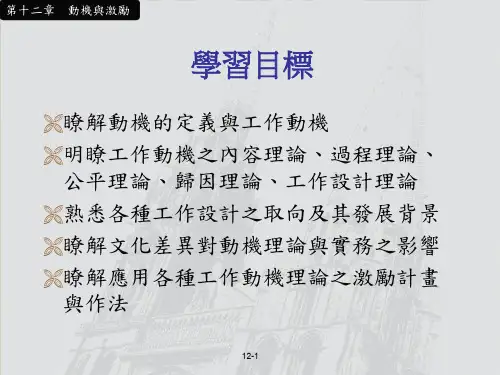
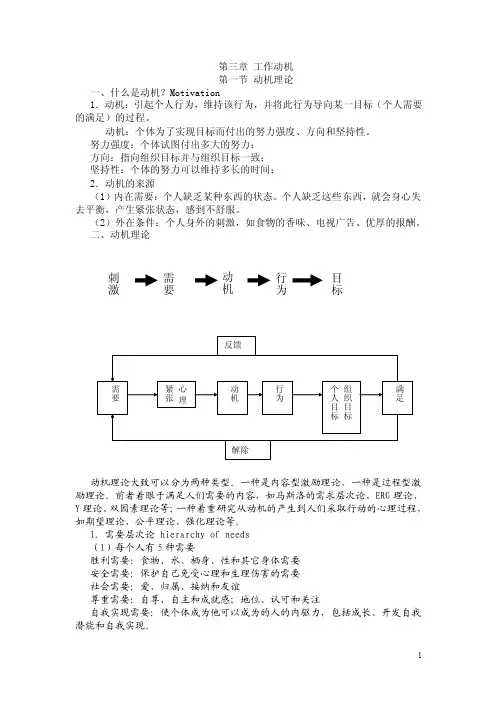
第三章 工作动机第一节 动机理论一、什么是动机?Motivation1.动机:引起个人行为,维持该行为,并将此行为导向某一目标(个人需要的满足)的过程。
动机:个体为了实现目标而付出的努力强度、方向和坚持性。
努力强度:个体试图付出多大的努力;方向:指向组织目标并与组织目标一致;坚持性:个体的努力可以维持多长的时间;2.动机的来源(1)内在需要:个人缺乏某种东西的状态。
个人缺乏这些东西,就会身心失去平衡,产生紧张状态,感到不舒服。
(2)外在条件:个人身外的刺激,如食物的香味、电视广告、优厚的报酬。
二、动机理论动机理论大致可以分为两种类型。
一种是内容型激励理论,一种是过程型激励理论。
前者着眼于满足人们需要的内容,如马斯洛的需求层次论、ERG 理论、Y 理论、双因素理论等;一种着重研究从动机的产生到人们采取行动的心理过程,如期望理论、公平理论、强化理论等。
1.需要层次论 hierarchy of needs(1)每个人有5种需要胜利需要:食物、水、栖身、性和其它身体需要安全需要:保护自己免受心理和生理伤害的需要社会需要:爱、归属、接纳和友谊尊重需要:自尊、自主和成就感;地位、认可和关注自我实现需要:使个体成为他可以成为的人的内驱力,包括成长、开发自我潜能和自我实现。
需要 动机刺激 行为 目标(2)当任何一种需要得到满足后,下一层需要就会成为主导需要。
评论:①直观逻辑性和易于理解;②缺乏实证材料。
2.ERG理论 ERG theory耶鲁大学的克莱顿〃奥尔德弗修改了需求层次论,提出了ERG理论。
(1)存在三类核心需求:存在需求Existence:关注于满足基本的物质存在要求,包括需求层次论的生理需求和安全需求。
关系需求Relatedness:维持人际关系的愿望,包括需求层次论的社会需要以及尊重需要中的外在部分。
成长需求Growth:对于个人发展的内在愿望,包括需求层次论的自我实现需要和尊重需要的内在部分。
(2)多种需要可以并存;(3)如果高层次的需要受到抑制而未能得到满足,那么满足低层次的需要的愿望会更强烈。
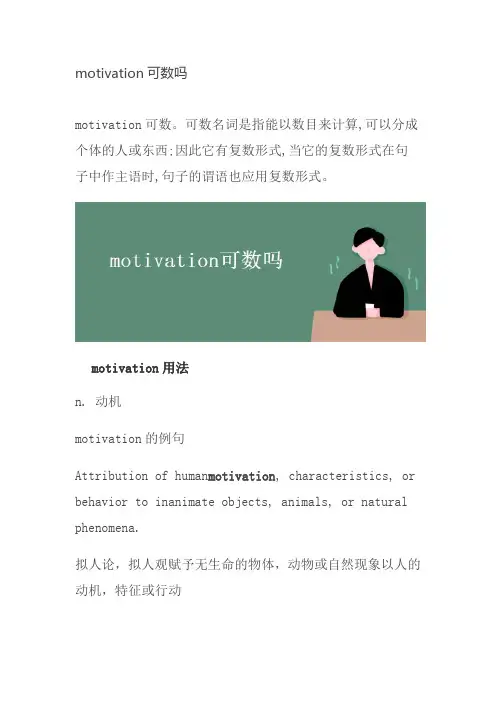
motivation可数吗
motivation可数。
可数名词是指能以数目来计算,可以分成个体的人或东西;因此它有复数形式,当它的复数形式在句子中作主语时,句子的谓语也应用复数形式。
motivation用法
n. 动机
motivation的例句
Attribution of human motivation, characteristics, or behavior to inanimate objects, animals, or natural phenomena.
拟人论,拟人观赋予无生命的物体,动物或自然现象以人的动机,特征或行动
罗马不是一日建成的。
单词背诵需要大家使用正确的方法以及持之以恒的努力。
希望17的小伙伴们在自己的努力下,顺利的拿下5500考研词汇,为将来的进一步学习打下夯实的基础。
motivation的短语搭配
learning motivationn. 学习动机
intrinsic motivation内在动机;内在激励
achievement motivation成就动机
motivation to learn学习的动机
internal motivation内在动机
work motivation工作动机
extrinsic motivation外在动机;外在激励;外加激励motivation theories激励理论
academic motivation学习动机
personal motivation个人动机。
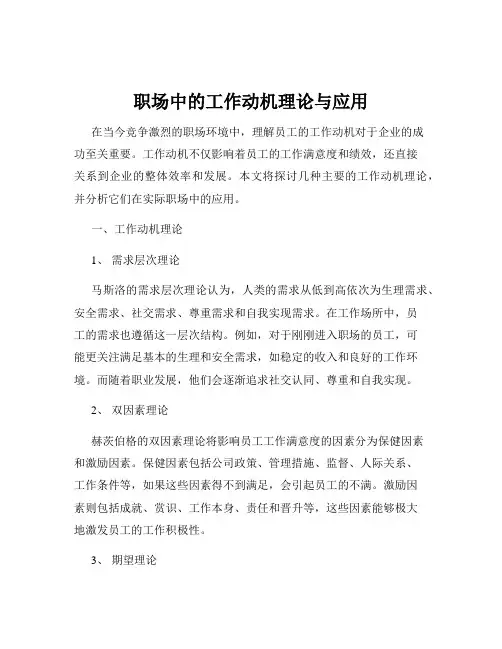
职场中的工作动机理论与应用在当今竞争激烈的职场环境中,理解员工的工作动机对于企业的成功至关重要。
工作动机不仅影响着员工的工作满意度和绩效,还直接关系到企业的整体效率和发展。
本文将探讨几种主要的工作动机理论,并分析它们在实际职场中的应用。
一、工作动机理论1、需求层次理论马斯洛的需求层次理论认为,人类的需求从低到高依次为生理需求、安全需求、社交需求、尊重需求和自我实现需求。
在工作场所中,员工的需求也遵循这一层次结构。
例如,对于刚刚进入职场的员工,可能更关注满足基本的生理和安全需求,如稳定的收入和良好的工作环境。
而随着职业发展,他们会逐渐追求社交认同、尊重和自我实现。
2、双因素理论赫茨伯格的双因素理论将影响员工工作满意度的因素分为保健因素和激励因素。
保健因素包括公司政策、管理措施、监督、人际关系、工作条件等,如果这些因素得不到满足,会引起员工的不满。
激励因素则包括成就、赏识、工作本身、责任和晋升等,这些因素能够极大地激发员工的工作积极性。
3、期望理论弗鲁姆的期望理论指出,员工的工作动机取决于他们对工作结果的期望以及该结果对自身的价值。
如果员工认为自己的努力能够带来期望的成果,并且这些成果对他们具有足够的吸引力,那么他们就会有强烈的工作动机。
4、公平理论亚当斯的公平理论强调员工会将自己的投入与产出与他人进行比较,如果感到不公平,就会影响工作积极性。
公平感不仅取决于绝对报酬,还取决于相对报酬。
二、工作动机理论在实际职场中的应用1、满足员工的不同需求企业管理者应了解员工处于需求层次的哪个阶段,并采取相应的措施。
对于关注生理和安全需求的员工,提供有竞争力的薪酬和稳定的工作环境。
对于追求社交和尊重需求的员工,组织团队活动,给予公开的表扬和认可。
对于渴望自我实现的员工,提供具有挑战性的项目和晋升机会。
例如,一家科技公司为新入职的员工提供高于行业平均水平的薪资和完善的福利,满足他们的基本需求。
对于工作多年、经验丰富的员工,给予他们领导团队的机会,让他们能够在工作中实现自我价值。
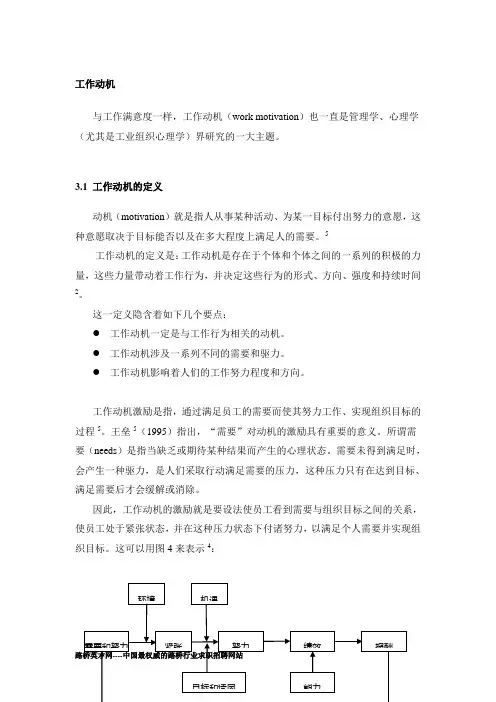
工作动机与工作满意度一样,工作动机(work motivation)也一直是管理学、心理学(尤其是工业组织心理学)界研究的一大主题。
3.1 工作动机的定义动机(motivation)就是指人从事某种活动、为某一目标付出努力的意愿,这种意愿取决于目标能否以及在多大程度上满足人的需要。
5工作动机的定义是:工作动机是存在于个体和个体之间的一系列的积极的力量,这些力量带动着工作行为,并决定这些行为的形式、方向、强度和持续时间2。
这一定义隐含着如下几个要点:●工作动机一定是与工作行为相关的动机。
●工作动机涉及一系列不同的需要和驱力。
●工作动机影响着人们的工作努力程度和方向。
工作动机激励是指,通过满足员工的需要而使其努力工作、实现组织目标的过程5。
王垒5(1995)指出,“需要”对动机的激励具有重要的意义。
所谓需要(needs)是指当缺乏或期待某种结果而产生的心理状态。
需要未得到满足时,会产生一种驱力,是人们采取行动满足需要的压力,这种压力只有在达到目标、满足需要后才会缓解或消除。
因此,工作动机的激励就是要设法使员工看到需要与组织目标之间的关系,使员工处于紧张状态,并在这种压力状态下付诸努力,以满足个人需要并实现组织目标。
这可以用图4来表示4:图4 动机激励模型3.2 工作动机激励的主要理论近50年以来,学术界对工作动机的激励进行了大量的研究,许多人都提出过不同的激励理论,其中一些具有代表性的理论已经在组织管理实践中得到了不同程度的应用和检验。
下面简要回顾一下工作动机激励的主要理论。
3.2.1 需要层次理论需要层次理论(hierarchy of needs theory)是由马斯洛提出的。
这一理论认为人类需要的强度不都是相等的,是按照一定顺序出现的5,而人的需要由低到高可以分为五种层次4:●生理需要(physiological needs):包括食物、水、掩蔽所、性等身体需要;●安全需要(safety needs):保障身心免受伤害;●归属和社会的需要(love needs):包括情感、归属、被接纳、友谊等需要;●尊严的需要(esteem needs):包括内在的尊重如自尊心、自主权、成就感等需要与外在的尊重如地位、认同、受重视等需要。
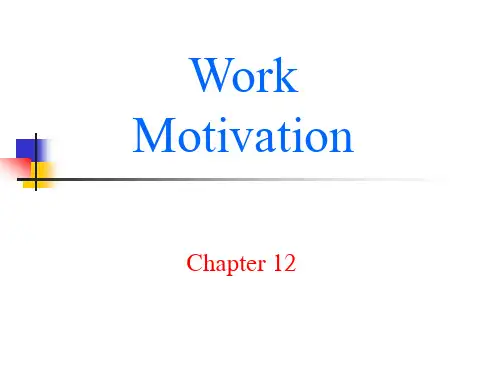


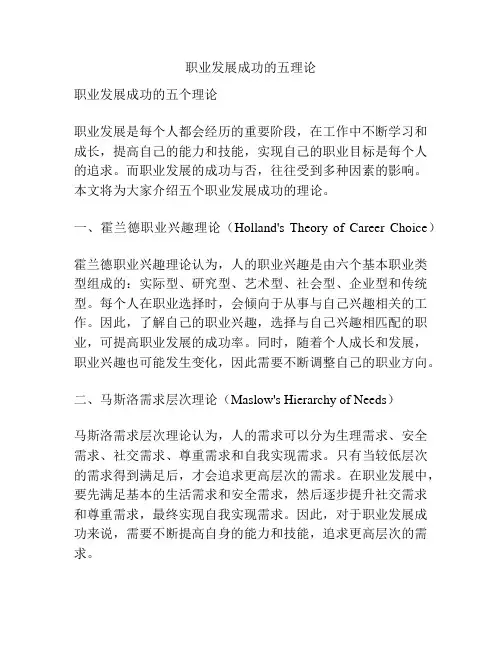
职业发展成功的五理论职业发展成功的五个理论职业发展是每个人都会经历的重要阶段,在工作中不断学习和成长,提高自己的能力和技能,实现自己的职业目标是每个人的追求。
而职业发展的成功与否,往往受到多种因素的影响。
本文将为大家介绍五个职业发展成功的理论。
一、霍兰德职业兴趣理论(Holland's Theory of Career Choice)霍兰德职业兴趣理论认为,人的职业兴趣是由六个基本职业类型组成的:实际型、研究型、艺术型、社会型、企业型和传统型。
每个人在职业选择时,会倾向于从事与自己兴趣相关的工作。
因此,了解自己的职业兴趣,选择与自己兴趣相匹配的职业,可提高职业发展的成功率。
同时,随着个人成长和发展,职业兴趣也可能发生变化,因此需要不断调整自己的职业方向。
二、马斯洛需求层次理论(Maslow's Hierarchy of Needs)马斯洛需求层次理论认为,人的需求可以分为生理需求、安全需求、社交需求、尊重需求和自我实现需求。
只有当较低层次的需求得到满足后,才会追求更高层次的需求。
在职业发展中,要先满足基本的生活需求和安全需求,然后逐步提升社交需求和尊重需求,最终实现自我实现需求。
因此,对于职业发展成功来说,需要不断提高自身的能力和技能,追求更高层次的需求。
三、自我决定理论(Self-Determination Theory)自我决定理论认为,个人在职业发展中是主动参与的,主动性和自主性对于成功的职业发展非常重要。
个人的动机可以分为外在动机和内在动机,内在动机更有助于个人的成长和发展。
因此,在职业发展中,要寻找自己的内在动机,发挥个人的主动性和自主性。
四、社会学习理论(Social Learning Theory)社会学习理论认为,人的职业发展受到他人的影响和社会环境的约束。
通过观察他人的职业成功经验和教育培训,可以学习到一些职业技能和经验。
同时,要善于利用社交网络和人际关系,寻找合适的职业机会和资源。
工作动机工作动机(Work Motivation)[编辑]什么是工作动机工作动机是一种心理状态,指的是一系列激发与工作绩效相关的行为,并决定这些行为的形式、方向、强度和持续时间的内部与外部力量。
动机是个体动力系统的重要组成部分,是行为的原动力,也是行为的直接驱动力量。
工作动机是最有效能、最为复杂的社会性动机之一,是一种使个体努力工作,高质量创新并不断完善自己工作的动机。
对中国企业人员而言,工作动机主要表现为自我决定、追求胜任、关系取向、他人评价、外在报酬与工作愉悦。
[编辑]工作动机的成份在1975年Steer和Porter对工作动机定义为:影响工作情境中行为之激发、导向与持久的状态。
他们指出工作动机有三种成份:第一种成份是激发:指个体内激发行为的力量。
第二种成份是导向:人们会针对某个特定情境努力,对于其它的情境则不会有同样的投入。
他们认为一个好的动机理论应该能够解释人们为何会做出这些选择。
第三种成份是持久:人们可能会持续从事某些工作,工作动机理论关心的是工作者较长时间的行为表现。
[编辑]工作动机的理论工作动机的理论基于不同的人性观,它涉及了一个问题:人为什么工作?回答这个问题有四个理论——X理论、Y理论、V理论和Z理论。
X理论认为人工作是为了钱,个人的工作动机来自于物质利益的驱动,并且常被外来刺激(诱因)所吸引。
Y理论则把人看作是负责、有创造力的,人们工作不是为了外在的物质刺激,而是出于一种要将工作做好的内驱力。
根据这种观点,在工作激励中不应将物质利益的吸引力放在第一位,而应创造一个自由的工作环境,让工作者有充分的空间发挥他们的创造力,满足他们对工作的内在需求。
V理论认为,个体的工作动机水平倾于为实现自身的价值观而付出的努力,有雄心的人们个人价值观比较高,并且会努力在工作中寻求实现和证明。
Z理论认为,当个人价值观与组织的目标协调一致时,个体的工作动机、士气和忠诚度都会得到提高。
工作动机来自不同工作需要的驱动,不管人的工作动机来自什么需要,它总是人们不辞辛苦地勤奋工作的强大动力。
工作动力理论与人员激励理论人员激励与工作报酬一、工作动力理论与人员激励理论1、动力理论概述动力理论是回答人的工作的动机与驱动力问题的理论。
A、外在动力理论即有形成或无形地施加于人的一种外在力量,其实质是一种社会性的驱动力,它促使人们不断确立新的目标,创造更大的绩效。
人具有社会性。
1.竞争动力:竞争就是两方或多方的个人或集团在一定范围为了夺取他们所他需要的对象而展开较量的过程。
2.社会舆论动力:舆论是一种社会性性的约束,具有社会监督和社会激励机制。
3.榜样动力:榜样是社会中自然形成的具有一定超越性的典范。
B、内在动力理论{或动机理论} 内在动力是由不同类型的动机促使成的,而动机是一种由需要所推动以达到一定目标的行为动力。
动机:引起某种行为、维持该行为,并将该行为导向一定目标的心理过程。
动机是需要与目标、行为方式的结合。
动机有始发功能---产生某种行动、有选择和导向功能---指导选择使行动朝特定方向进行、强化功能---行为结果对动机具有反作用。
动机划分为:成就动机、亲和动机、能力动机、权利动机。
原始动机、一般动机、习得动机1.个体行为的基本模式需要---内驱力---目标2.动机产生的条件:动机是个体行为被引起、维持和指向某一目标的过程。
3.动机的选择:影响动机抉择的因素:是认识、兴趣和评价:4.价值观取向1.理论性价值观{以知识、真理为中心};2.美的价值观{以形式和谐为中心}3.政治性价值观{以权利、地位为中心};4社会价值观{以群体、他人为中心},5.经济性价值观{以有效实惠为中心};6.宗教性价值观{以信仰为中心}态度:人们对对象反应的一种具有内在的稳定的心理准备状态和行为倾向。
认知、情感、意向三个因素组成态度转变服从、同化、内化。
目标动力理论:目的性是人类自身行为的特点。
所谓目的,即行为的预期结果。
当人们将目的具体化时,就形成了目标。
目标:是人们行为的最终目的。
1.目标难度2. 目标明确性3. 目标激励的扩充模型团体动力理论德国心理学家卢因认为;这里的团体是指组织中的非正式组织,这样的团体有不同于组织的目标和不十分清楚的组织结构,但团体内的成员也有共同的行为规范。
Contents of this page include:•Maslow•Hertzberg•Elton Mayo•Handy•Mcgregor theory X and Y•Ouchi theory Z•Lean and mass productionMaslow’s hierarchy of needs:Maslow showed how an individual’s emphasis on needs moved from basic to the higher needs. The needs at the bottom must be satisfied to move at the higher ones. Needs do not have to be completely satisfied before higher needs emerge, a sufficient level of satisfaction is acceptable as opposed to the maximum or optimum level.Maslow’s theory may be summarized and simplified by saying that everyone wants certain things throughout life, and these things can be placed in five ascending categories namely:Basic or physiological needs: the things needed to stay alive: food, shelter and clothing. Such needs can be satisfied by money.Safety or security needs: people want protection against, unemployment, retirement as well as being safeguarded against unfair treatment. These needs can be satisfied by the rules of employment i.e pension scheme, sick fund, employment legislation.Social needs: the vast majority of people want to be part of a group and it is only through group activity that this need can be satisfied. Thus it is up to the organization to make the employee feel part of a group.Ego or Esteem needs: e.g. can include employee being asked to lead a group in a project. This enables the employee to think well of himself and in his abilities. This can be satisfied if the say or suggestion of the employee is taken into account and/or he is asked to lead or be part of an important task.Self-actualization or self-fulfillment needs: this is quite the need to achieve something worthwhile in life. It is a need that is satisfied only by continuing success, for example opening and running a new office.EVALUATION OF MASLOW:The significance of maslow’s hierarchy of needs is that if underlines the relative importance of money. Status gives little satisfaction to a person desperate for food and shelter.On the other hand it demonstrates that money alone is not enough, and indeed as basic needs are satisfied people arelikely to concentrate their attentions on social and ego needs.Herzberg’s theory of motivation:Herzberg attempted to find out what motivated people at work. He developed the two-factor theory that was based on the idea that motivation is based on two needs, namely hygiene factors and motivational factors.Hygiene factors: are those that have to do with non-job related features such as the working environment.Motivational factors: are those concerned with a need for personal development.Hygiene factors: factors that need to be met to prevent dissatisfaction. Will not motivate in themselves, they are concerned with extrinsic factors associated with the job itself but are not directly a part of it. The important fact to remember is that attention to these hygiene factors prevents dissatisfaction but does not necessarily provide positive motivation.•Pay•Conditions•Company policy•Relationships with higher levels, such as management •Treatment at work•Inability to develop•Feelings of inadequacyMotivators: factors which motivate: the main motivation factor are not in the environment but in the intrinsic value and satisfaction gained from the job itself. Motivation factors include:•Sense of achievement•Chance of promotion•Chance of improvement•Recognition of effort•Responsibility•Nature of job itselfElton Mayo (Hawthorne Studies)Mayo’s most important contribution was to identify the basis of work satisfaction as non-economic and to connect it more with the interest taken in the worker’s performance than with the financial reward.Okay here’s what happened in plain simple words:• A test was conducted on 6 women which lasted for five years •The test was conducted so as to observe the effect on output and morale of various changes in working conditions.•Initially, an incentive payment scheme was introduced; then rest periods in different forms. Changes were made in the hours of work etc.•CONCLUSION: it was found that whatever changes were made including a return to the original conditions, output still rose!•The output recorded over time kept on increasing.Evaluation: it was apparent that the changes in working conditions could not account for the increase in output –this was due to the enhanced work satisfaction that the girls enjoyed, the development of personal friendships, and a new social atmosphere, which brought a marked change in their attitude towards work.Mcgregor’s theories:Theory X: assumes that people dislike work and responsibility. Therefore they must be coerced, controlled, directed or threatened with punishment to get them to make an effort towards achievement of organizational objectives. However modern employment laws have made this difficult for managers. For this reason a ‘carrot’ approach is used. People have to be persuaded to carry out tasks by promises or rewards. In many ways this is similar to Taylor’s view.Theory Y: assumes that most people are motivated by those things at the top of Maslow’s hierarchy. In other words, people are responsible, committed and enjoy having controlover work. Most people, given the opportunity, will get involved in work and contribute towards the solution of a problem that may arise.IN OTHER WORDS:THEORY X is pessimistic and rigid. Control is primarily external i.e. imposed on the subordinate by the superior.THEORY Y is optimistic, dynamic and flexible, with an emphasis o self-direction and the integration of individual needs with organizational demands.Ouchi theory ZIn theory Z there is an emphasis on the interpersonal skills that form the basis of group working, where decision making is by consensus, but responsibility remains with the individual.There is emphasis on building trust through informal and democratic relationships.The characteristics of the theory z organizations are:•Long term employment•Slow evaluation and promotion•Moderately specialized careers•Consensual decision making•Individual responsibility- this could mean giving greater responsibility lower down the line•Concern for the employeeLEAN PRODUCTIONLean production is divided into the following sectors:•Kaizen•Just in time manufacturing•Time based management•Empowerment•TeamworkingKaizen is perhaps the most concept in Japanese management. It means continuous improvement. In western businesses productivity remains the same for long periods of time, then suddenly rises. The increase is followed by another period of stability, before another rise. Increases in productivity may result from new working practices or new technology. The dotted line below shows the Japanese approach. Improvements are continuous. They result from changes in production techniques.the kaizen is said to be an umbrella concept. A wide range of different production techniques and working practices must be carried out for it to be effective. These include:•Zero defect policies•Total quality management•Quality control circles•Automation•Just in timeIt is difficult for workers in the business to look for continuous improvement all the time. In order to solve this problem a system was introduced namely PDCA (plan, do, check, action)Plan: business must identify where improvement is needed. Data must be gathered and used to develop a plan which will result in improvement.Do: once the plan has been finalized it must be carried out. Check: the next stage in the cycle is to check whether or not there has been an improvement.Action: if the plan has been successful, it must be introduced in all parts of the business.Just in time manufacturing:JIT: just in time manufacturing is an important part of lean production. It is defined as for example in any manufacturing and selling organization: ‘raw materials being delive red JIT to be made into parts, parts were delivered JIT to be made into goods and goods were produced and delivered JIT to be sold.’Advantages:•It improves cash flow as money is not tied up in stock •The system reduces waste•Since no stock is held the excess factory space can be used for something else•Links with and the control of suppliers is improved Disadvantages:• A lot of faith is placed in the reliability and flexibility of suppliers•Increased order costs•Advantages of bulk discounts is lost•Difficult to cope up with sharp increases in demandTime-based management:Time based mgt involves reducing the amount of time businesses take carrying out certain tasks, such as launching new products or cutting lead times in production. Time based mgt is a feature of lean production because it involves eliminating a type of waste i.e. time.Advantages:•Customers will benefit. A wider range of products will be available and there will be faster delivery times. •Increased efficiency will benefit the company by improving it’s image in the eyes of the people•The time spent on range of production tasks is reduced.This helps to improve productivity and reduce unit costs.Empowerment:Empowerment involves giving employees the power to make decisions in a business. The aim of empowerment is to give employees more control over their own work conditions.Businesses have now learnt that efficiency will improve if workers are given the opportunity to involve themselves in decision making. Workers will be better motivated and the business may gain from the creativity of its workers.Empowerment is not without difficulties. Some workers may not be able to make their own decisions and training may be required to teach them such skills. Mangers may resent givingup authority. Some staff may even abuse their power to make decisions.Team working:A growing number of businesses are introducing team working. This involves dividing the workforce into fairly small groups. Each team will focus on particular areas of production and team members will have the same common aims.Effective teamworking requires cooperation between workers and management. Both the business and employees can benefit from team working. Workers should develop relationships with colleagues and a team spirit which may improve motivation and productivity. Flexibility will improve. For example team members might be more willing to cover for an absent colleague.MASS production欢迎您的下载,资料仅供参考!。
工作动机理论在组织行为学中的应用工作动机是指个体在工作环境中产生积极性、目标导向的心理状态。
在组织行为学领域,工作动机理论被广泛应用于解释和预测员工的行为和绩效。
了解工作动机理论的应用,可以帮助组织更好地管理和激励员工,提高组织绩效。
一、马斯洛的需求层次理论马斯洛的需求层次理论认为,人的需求可以分为生理需求、安全需求、社交需求、尊重需求和自我实现需求五个层次。
在组织行为学中,这一理论经常被用来解释员工的激励机制。
管理者可以通过满足员工不同层次的需求,来激发员工的工作动机。
例如,提供良好的工作条件和薪资福利,可以满足员工的生理和安全需求;搭建团队合作和社交交流的平台,可以满足员工的社交需求;提供晋升和发展机会,可以满足员工的尊重和自我实现需求。
二、赫茨伯格的双因素理论赫茨伯格的双因素理论将工作动机分为满足型和发展型两种因素。
满足型因素包括工资、福利和工作条件等,缺乏这些因素会导致员工不满意,但满足这些因素并不能真正激发员工的工作动机。
而发展型因素则包括工作内容的挑战性、成长机会和自主权等,这些因素能够真正激发员工的内在动机和积极性。
组织可以通过提供有挑战性的工作任务和鼓励员工主动参与决策,来激发员工的工作动机,提高其工作表现。
三、期望理论期望理论认为,员工的行为选择取决于他们对不同行为结果的期望程度。
具体而言,期望理论包括三个要素:期望、工具性和价值观。
期望是指员工对完成某项任务后获得成功的信念;工具性是指员工相信完成这项任务所需的工作技能和资源;价值观是指员工对任务结果的重视程度。
组织可以通过强化员工的期望、提供必要的工作技能培训和资源支持以及激励员工认可任务结果的重要性,来提高员工的工作动机和工作绩效。
四、公平理论公平理论认为,员工对待遇的公平性和正义性有着强烈的期望和需求。
如果员工认为自己的工作待遇与付出不成比例,就会感到不满意并缺乏工作动机。
因此,组织应该确保员工的工作待遇公平和正义,遵守公平原则,提供公平的晋升机会和薪资福利分配,以增强员工的工作动机。
【外文翻译】工作激励理论的未来工作激励理论的未来在管理领域,无论是从实际上,还是从理论上来说,员工激励都是最重要的组成部分。
经理人把激励当作绩效结果的组成部分,而研究组织的人员则把激励当作有效的管理理论实践的重要组成部分。
事实上,激励主题贯穿在许多的分支组成的管理研究,包括领导能力,团队,绩效管理,管理伦理,决策和组织的变化。
这并不奇怪,因此,这个话题已经受到几十年来很多的关注。
鉴于最近几篇文章的研究,我们研究工作的热情来了,这论坛的重点在哪里,也就是说,我们问的问题:什么是工作动机理论的未来?什么是必须解决的?什么是在这个领域取得进展的关键性问题?什么是未来的研究议程?我们如何延续现有的成绩,使他们在未来得到相关的发展?在哪里需要当代组织中完全理解的崭新的激励模式?要明白我们研究的是哪个领域,我们必须首先明白这点。
此次,我们对工作动机领域从理论的角度概述,奠定后面文章的基础。
动机这个词源于拉丁词运动,阿特金森定义为“当代的影响方向,活力和持久性的行动”动机(1964年:2),而弗鲁姆将其定义为“一个过程中,人在管理上的选择,其中代替志愿活动”(1964年:6)。
坎贝尔和普里查德认为,动机,是因为有一个独立的关系,解释变量的方向,幅度和个人行为的持久性,保持恒定的资质,掌握技能,理解任务,在约束的环境下运作(1976)。
这些和其他的定义有三个共同点,他们主要关注的因素有活力,渠道,长时间地维持人类的行为。
以各种方式了解努力工作的动力,从理论上阐明在当代这三个因素如何得到越来越精确的相互联系,以确定组织的行为。
激励理论的“黄金时代”在20世纪60年代中期开始,出现了一个新的方法来研究工作动机,把过程中的相关工作动机作为重点。
过程理论与早期的内容理论形成了鲜明的对比,确定与激励相关的一个相对静态的环境因素为重点,从动态的角度观察工作动机,寻求在工作场所中工作动机与人类行为的因果关系。
过程理论,是一系列认知理论的统称,试图了解人们在工作场合的行为的思维过程。